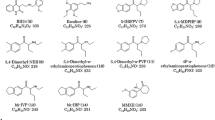Abstract
Hallucinogenic tryptamine analogues, an important class of drugs of abuse, can be naturally occurring or chemically synthesized compounds. In Japan, psilocin and psilocybin (ingredients of “magic mushrooms”) and 5-methoxy-N,N-diisopropyltryptamine (5-MeO-DIPT; a synthetic tryptamine) seem to be particularly problematic due to their extensive abuse. This review is focused on human metabolism and forensic toxicological analyses of the above three tryptamine analogues. In humans, psilocybin is rapidly dephosphorylated to form psilocin, and most of the psilocin is eventually conjugated to form its glucuronide. On the other hand, 5-MeO-DIPT is mainly metabolized via O-demethylation, 6-hydroxylation, and N-deisopropylation, partly followed by conjugation to form their sulfates and glucuronides. Suitable hydrolysis should be, therefore, applied for sensitive and effective analysis of the metabolites. In analyzing psilocin and psilocybin by gas chromatography-mass spectrometry (GC-MS), derivatization is necessary for their discriminative identification. Although 5-MeO-DIPT and its three major metabolites can be analyzed by GC-MS without any derivatization, trimethylsilyl derivatization provides improvement of their peak shapes and intensities. In contrast to GC-MS, liquid chromatography-mass spectrometry and liquid chromatography-tandem mass spectrometry allow us not only to discriminate psilocin and psilocybin without derivatization, but also to directly analyze their conjugated metabolites.
Similar content being viewed by others
References
Fantegrossi WE, Murnane KS, Reissig CJ (2008) The behavioral pharmacology of hallucinogens. Biochem Pharmacol 75:17–33
Hofmann A, Heim R, Brack A, Kobel H (1958) Psilocybin, ein psychotroper Wirkstoff aus dem mexikanischen Rauschpilz Psilocybe mexicana Heim. Experientia 14:107–109
Shulgin AT, Carter MF (1980) N,N-Diisopropyltryptamine (DIPT) and 5-methoxy-N,N-diisopropyltryptamine (5-MeODIPT). Two orally active tryptamine analogs with CNS activity. Commun Psychopharmacol 4:363–369
Uchiyama N, Kikura-Hanajiri R, Kawahara N, Goda Y (2009) Identification of a cannabimimetic indole as a designer drug in a herbal product. Forensic Toxicol 27:61–66
Kikura-Hanajiri R, Kawamura M, Maruyama T, Kitajima M, Takayama H, Goda Y (2009) Simultaneous analysis of mitragynine, 7-hydroxymitragynine, and other alkaloids in the psychotropic plant “kratom” (Mitragyna speciosa) by LC-ESI-MS. Forensic Toxicol 27:67–74
Kamata T, Nishikawa M, Katagi M, Tsuchihashi H (2003) Optimized glucuronide hydrolysis for the detection of psilocin in human urine samples. J Chromatogr B 796:421–427
Kamata T, Nishikawa M, Katagi M, Tsuchihashi H (2006) Direct detection of serum psilocin glucuronide by LC/MS and LC/MS/MS: time-courses of total and free (unconjugated) psilocin concentrations in serum specimens of a “magic mushroom” user. Forensic Toxicol 24:36–40
Kamata T, Katagi M, Kamata HT, Miki A, Shima N, Zaitsu K, Nishikawa M, Tanaka E, Honda K, Tsuchihashi H (2006) Metabolism of the psychotomimetic tryptamine derivative 5-methoxy-N,N-diisopropyltryptamine in humans: identification and quantification of its urinary metabolites. Drug Metab Dispos 34:281–287
Kamata T, Katagi M, Kamata H, Miki A, Shima N, Zaitsu K, Nishikawa M, Tsuchihashi H (2007) Urinary excretion profiles of 5-methoxy-N,N-diisopropyltryptamine and its relevant metabolites in humans. J Health Sci 53:585–590
Horita A, Weber LJ (1961) The enzymic dephosphorylation and oxidation of psilocybin and psilocin by mammalian tissue homogenates. Biochem Pharmacol 7:47–54
Horita A, Weber LJ (1962) Dephosphorylation of psilocybin in the intact mouse. Toxicol Appl Pharmacol 4:730–737
Sticht G, Käferstein H (2000) Detection of psilocin in body fluids. Forensic Sci Int 113:403–407
Grieshaber AF, Moore KA, Levine B (2001) The detection of psilocin in human urine. J Forensic Sci 46:627–630
Hasler F, Bourquin D, Brenneisen R, Bär T, Vollenweider FX (1997) Determination of psilocin and 4-hydroxyindole-3-acetic acid in plasma by HPLC-ECD and pharmacokinetic profiles of oral and intravenous psilocybin in man. Pharm Acta Helv 72:175–184
Hasler F, Bourquin D, Brenneisen R, Vollenweider FX (2002) Renal excretion profiles of psilocin following oral administration of psilocybin: a controlled study in man. J Pharm Biomed Anal 30:331–339
Lindenblatt H, Kramer E, Holzmann-Erens P, Gouzoulis-Mayfrank E, Kovar KA (1998) Quantitation of psilocin in human plasma by high-performance liquid chromatography and electrochemical detection: comparison of liquid-liquid extraction with automated on-line solid-phase extraction. J Chromatogr B 709:255–263
Meatherall R, Sharma P (2003) Foxy, a designer tryptamine hallucinogen. J Anal Toxicol 27:313–317
Wilson JM, McGeorge F, Smolinske S, Meatherall R (2005) A foxy intoxication. Forensic Sci Int 148:31–36
Narimatsu S, Yonemoto R, Saito K, Takaya K, Kumamoto T, Ishikawa T, Asanuma M, Funada M, Kiryu K, Naito S, Yoshida Y, Yamamoto S, Hanioka N (2006) Oxidative metabolism of 5-methoxy-N,N-diisopropyltryptamine (Foxy) by human liver microsomes and recombinant cytochrome P450 enzymes. Biochem Pharmacol 71:1377–1385
Shima N, Kamata T, Kamata H, Zaitsu K, Katagi M, Tsuchihashi H (2007) Determination of 5-MeO-MIPT and its metabolites in blood and urine. Abstracts of the 127th Annual Meeting of The Pharmaceutical Society of Japan, 28P1-pm231 (CD-ROM)
Katagi M, Kamata T, Tsuchihashi H (2009) Identification of major urinary metabolites of tryptamine-derived hallucinogens. Abstracts of the 57th Annual Conference on Mass Spectrometry, Osaka, Japan, pp. 266–267
Chamakura RP (1994) Tryptamines. Microgram 27:316–329
Keller T, Schneider A, Regenscheit P, Dirnhofer R, Rücker T, Jaspers J, Kisser W (1999) Analysis of psilocybin and psilocin in Psilocybe subcubensis GUZMÄN by ion mobility spectrometry and gas chromatography-mass spectrometry. Forensic Sci Int 99:93–105
Vorce SP, Sklerov JH (2004) A general screening and confirmation approach to the analysis of designer tryptamines and phenethylamines in blood and urine using GC-EIMS and HPLC-electrospray-MS. J Anal Toxicol 28:407–410
Kamata T, Nishikawa M, Katagi M, Tsuchihashi H (2005) Liquid chromatography-mass spectrometric and liquid chromatography-tandem mass spectrometric determination of hallucinogenic indoles psilocin and psilocybin in “magic mushroom” samples. J Forensic Sci 50:336–340
Tanaka E, Kamata T, Katagi M, Tsuchihashi H, Honda K (2006) A fatal poisoning with 5-methoxy-N,N-diisopropyltryptamine, Foxy. Forensic Sci Int 163:152–154
Author information
Authors and Affiliations
Corresponding author
Rights and permissions
About this article
Cite this article
Kamata, T., Katagi, M. & Tsuchihashi, H. Metabolism and toxicological analyses of hallucinogenic tryptamine analogues being abused in Japan. Forensic Toxicol 28, 1–8 (2010). https://doi.org/10.1007/s11419-009-0087-9
Received:
Accepted:
Published:
Issue Date:
DOI: https://doi.org/10.1007/s11419-009-0087-9




